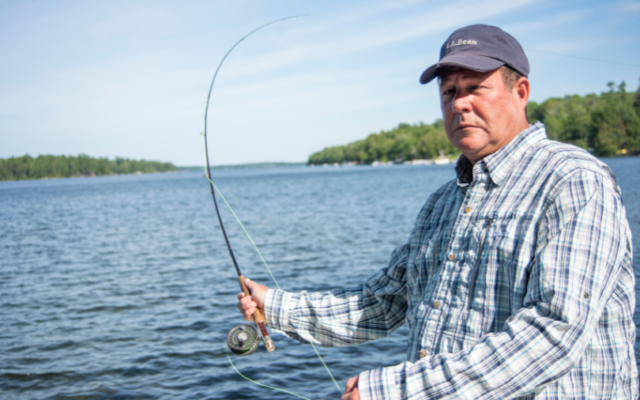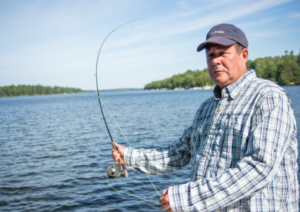
How to cast with a fly rod
My first experience with a fly rod was not encouraging.
I was young — maybe 7 years old — and I’d grabbed the green telescoping fiberglass fishing pole that I always used, and carried it to the brook near our camp.
When I showed it to my older, more worldly cousin, he scoffed. “You can’t use that,” he told me. “That’s a fly pole.”

Bangor Daily News photo/Natalie Williams
Bangor Daily News Outdoors Editor John Holyoke demonstrates how to throw a fly fishing line in Otis, Maine, on July 9
Undeterred, I hooked a worm to the hook that I’d attached to the end of the braided fly line, and might even have caught a few four-inch trout.
If I’d known how that “fly pole” actually worked, I might have been tempted to try my hand at fly casting, which was a totally foreign concept. Luckily for my ears, eyes (and fishing companions), I didn’t. So nobody got hooked.
The question that might have occurred to me that day still resonates with beginning fly fishers: How do I make this fly rod work?
Yes (lesson one): It’s a fly ROD. Not a fly POLE.
And here’s how you make it work. Or, at least, here are a few things you ought to know.
If you grew up fishing with a spinning rod, tossing worms or lures, as most of us did, you’re used to having a weighted lure at the end of an essentially weightless fishing line. The weight of that worm or lure carries the line with it when you cast.
Fly fishing presents the opposite situation. Your fly is (more or less) weightless, and the line has some real heft to it. The fly is carried forward because the line demands it. And the line demands it because the fly rod is flexible, and bends back and forth when you cast with it.
The key, then, is to get the line to “load” the rod, flexing it away from the direction you want to cast, then letting it “unload” when you present the fly to the hefty fish that’s waiting to eat it.
A good drill to practice this movement: Instead of lifting the rod up and over your casting shoulder, which you’d normally do during a cast, just wag it back and forth in front of you, with about 15 or 20 feet of fly line out beyond the uppermost guide. Watch the fly line swish to the right. Then, pause your rod when it crosses the center of your body, and wait for the line to straighten out. When it does, wag the rod back to the left, watching the line swish out in that direction. If you think of your rod tip as the hands on a clock, and picture 12 o’clock being right in front of you, try to stop your rod at 2 o’clock on the right side, and at 10 o’clock on the left.
Pro tip: Do this drill without a fly attached to your leader. You’re not fishing right now. You’re practicing. And the most important thing that you’re working on is learning to avoid hooking yourself.
After you get used to the feeling of the rod loading and unloading, feel free to move onto a more traditional casting stance. If you’re right-handed, let the line lie out on the water (or your back lawn) in front of you, then swiftly pick it up by swinging the rod over your right shoulder. Stop the rod when it gets to about 2 o’clock on the clock face we described earlier. Then, as soon as the fly line straightens out behind you (it’s OK to peek), push your right hand forward to initiate a forward cast.
Continue that motion, forward and back, forward and back, for eight or 10 repetitions. These are called “false casts.” Doing a few of these before letting the line lay out on the water or grass in front of you may or may not be needed when you’re actually fishing, but false casting is a good way for beginners to begin “feeling” the rod as it loads and unloads.
Two more pro tips: Don’t let your wrist get involved. Your forearm should remain rigid, and allowing your wrist to flex will turn a 10-and-2 rod path into a 9-and-3 path, or worse.
And as legendary caster Lefty Kreh advised, you don’t have to move your elbow up and down to make a good, strong cast. Kreh advised casters to “keep the elbow on the shelf” when casting, and if you picture that image, with your casting elbow sliding back and forth on a shelf, that cue will eliminate a lot of extraneous motion and strain on that elbow.
Have fun, and give it some practice. Heck, during the next lesson we might even let you tie a fly on your leader and go fishing!